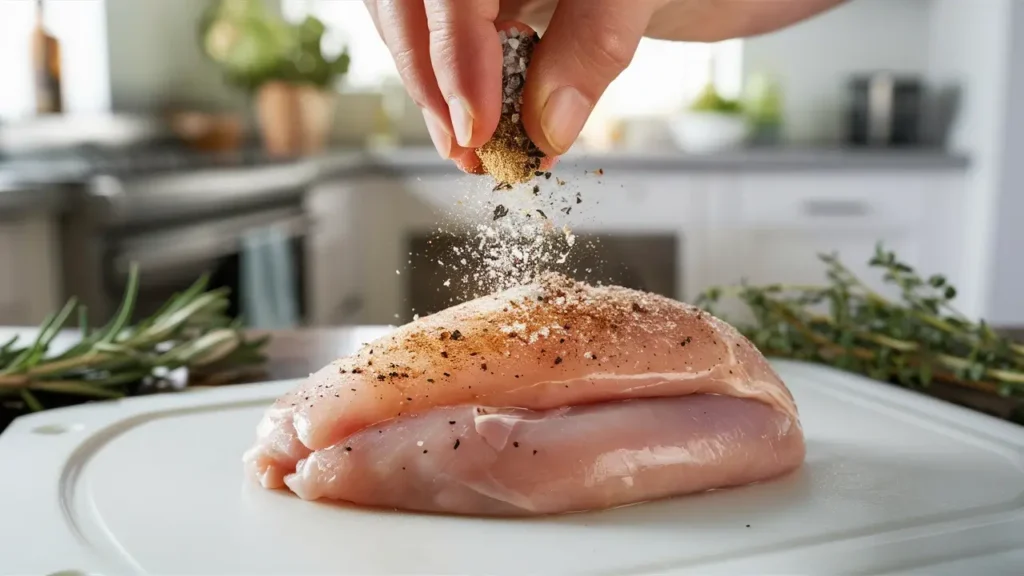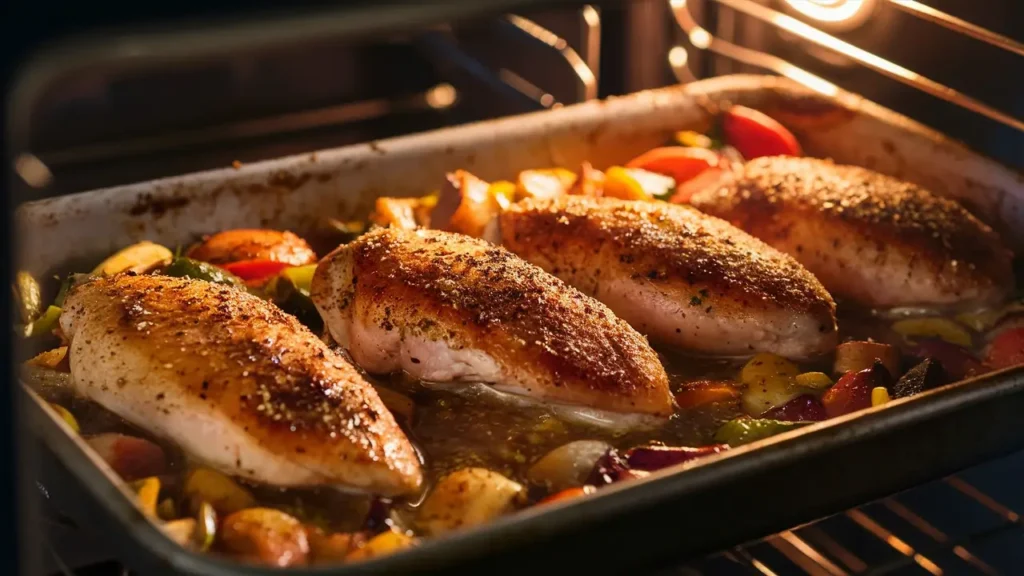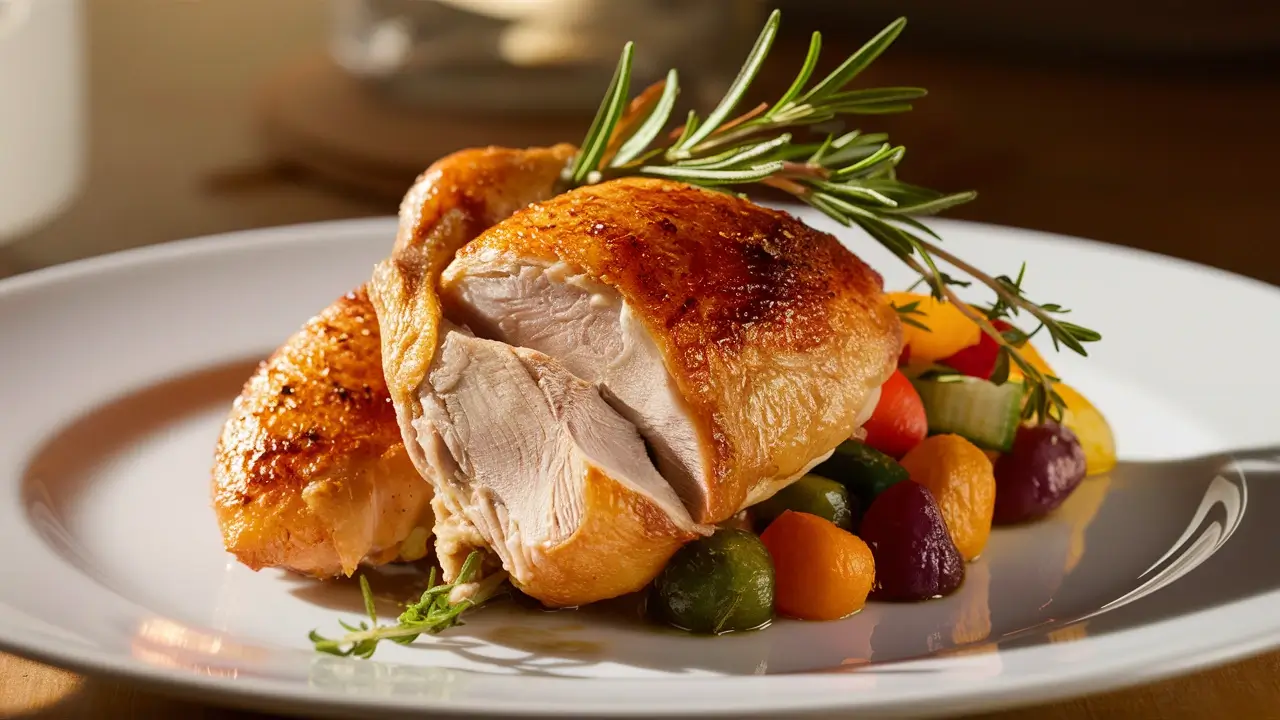When it comes to preparing a quick, healthy, and satisfying meal, few dishes are as versatile and delicious as baked chicken breast. Whether you’re cooking for one or feeding a family, a perfectly Roasted chicken breast can be a game-changer. In this guide, we’ll cover everything from the health benefits of baked chicken breast to how to prepare, season, and cook it to perfection. Whether you’re a novice or an experienced cook, you’ll find tips and tricks that will help you master this essential dish.
Now, let’s dive right into why Cooked chicken breasts should be your go-to choice for any meal.
Why Choose Baked Chicken Breast?
When you’re looking to prepare a meal that’s both tasty and healthy, baked chicken breast is an excellent option. It’s easy to make, packed with protein, and can be adapted to any flavor profile you like. But what exactly makes it so popular? Let’s break down the key reasons.
Health Benefits of Baked Chicken Breast
First and foremost, Baked poultry breast is incredibly healthy. It’s low in fat, especially when you choose boneless, skinless chicken breasts. This makes it a great option for those watching their calorie intake or trying to maintain a balanced diet. Additionally, chicken breast is rich in lean protein, which is essential for muscle building, tissue repair, and keeping your immune system strong. Plus, since it’s baked instead of fried, you can avoid the extra calories and unhealthy fats that come with other cooking methods.
Why Baked Chicken Breast is a Healthier Option Than Fried
Let’s face it: fried chicken may be mouthwatering, but it’s not exactly a health food. When you bake chicken breast, you’re keeping the calories low and the nutrients intact. Baked chicken doesn’t require added oils or butter (unless you want a bit of extra flavor), which keeps it much leaner than its fried counterpart. Plus, baking is a gentler cooking method that preserves the nutrients, leaving you with a juicy, tender, and much healthier dish.
Whether you’re following a fitness routine or just trying to make smarter food choices, baked chicken breast is the way to go. It’s simple, nutritious, and delicious—everything you want in a meal. Now that we’ve established why baked chicken breast should be your go-to, let’s move on to preparing it.
Tips for Cooking Perfect Baked Chicken Breast:
Cooking baked chicken breast to perfection might seem tricky, but with the right tips, you can achieve a juicy and flavorful result every time. Let’s dive into the steps that ensure your chicken comes out tender and perfectly cooked.
Choosing the Right Chicken Breast
When you’re planning to bake chicken breasts, one of the most important steps is choosing the right cut. Opt for fresh chicken breasts, and avoid pre-packaged frozen ones as they may lose moisture and tenderness during the baking process. Boneless chicken breasts are often a great option for even cooking, while bone-in breasts tend to have more flavor but require a bit more time in the oven.
Preparing Chicken Breast for Baking
Once you’ve chosen your chicken breasts, the next step is to prepare them for baking. Start by patting the chicken dry with paper towels, as this will help the seasoning adhere better. Then, you can either marinate your chicken for a few hours to infuse extra flavor or simply apply a seasoning blend before baking. For a basic seasoning, salt, pepper, garlic powder, and paprika can go a long way.
For added moisture, you can also consider brining your chicken beforehand (as discussed in Part 1). This will help the chicken retain moisture as it cooks, preventing it from drying out in the oven.
Baking Chicken Breast at the Perfect Temperature:

Add the perfect blend of spices to make your baked chicken breast extra flavorful.
Baking at the right temperature ensures that your baked chicken breast turns out tender and juicy. If you’ve ever had dry chicken, you know how frustrating it can be. Here’s how you can prevent that from happening.
Is It Better to Bake Chicken at 350 or 400 Degrees?
A common question when it comes to baking chicken breast is whether to use a temperature of 350°F or 400°F. Here’s the scoop: baking at 350°F is ideal for a slower cook that allows the meat to remain tender and juicy. This is a great option if you’re preparing several breasts at once. On the other hand, 400°F is perfect for a quicker bake, producing a crispy exterior while keeping the inside moist.
How Long Should You Bake Chicken Breast?
The cooking time for baked chicken breast largely depends on the size and thickness of the chicken. Generally, a chicken breast that weighs about 6-8 ounces should bake at 350°F for 25-30 minutes. You’ll know it’s done when the internal temperature reaches 165°F (check with a meat thermometer).
If you’re baking at 400°F, the cooking time might be slightly shorter, around 20-25 minutes. However, be cautious not to overcook the chicken, as it will dry out.
How to Avoid Dry Chicken Breast
The secret to keeping your baked chicken breast juicy is to avoid overcooking it. In addition to using a meat thermometer, consider covering your chicken with foil during the first 10-15 minutes of baking. This helps lock in moisture. Additionally, resting the chicken for 5-10 minutes after baking allows the juices to redistribute, ensuring a moist, flavorful bite.
To ensure your baked chicken breast is extra juicy and tender, check out our Chicken Brine Recipe for a flavorful soaking method.
Delicious Variations of Baked Chicken Breast:
Once you’ve mastered the basics of baking chicken breast, why not get creative? There are endless flavor variations you can explore to suit your preferences. Whether you’re in the mood for a zesty dish or a comforting classic, these options are sure to spice up your meal plan.
Classic Herb and Garlic Baked Chicken Breast
One of the simplest yet most flavorful ways to prepare baked chicken breast is by using fresh herbs and garlic. For a rich and aromatic profile, combine olive oil, minced garlic, rosemary, thyme, and a touch of lemon juice. Rub the mixture over your chicken breasts, and bake as usual. The result is a juicy, herb-infused chicken that pairs perfectly with roasted vegetables or a side of quinoa.
Baked Chicken Breast with a Sweet Glaze
If you’re craving a sweet-savory combo, consider glazing your baked chicken breast with honey or maple syrup. To make the glaze, mix honey with soy sauce, mustard, and a splash of apple cider vinegar for a tangy kick. This glaze will caramelize in the oven, creating a mouthwatering crispy exterior while keeping the chicken moist on the inside.
Spicy Baked Chicken Breast
For those who enjoy a little heat, a spicy baked chicken breast might be just what you need. Use a blend of chili powder, cayenne pepper, smoked paprika, and garlic powder to create a bold flavor profile. If you like, add a drizzle of hot sauce or a pinch of red pepper flakes before baking. This spicy twist adds a burst of flavor without overpowering the dish.
Frequently Asked Questions About Baked Chicken Breast:

Watch the magic happen as your chicken breast bakes to perfection.
When it comes to baking chicken breast, people often have a lot of questions. Let’s address some of the most common ones to help ensure your chicken turns out perfect every time.
Is it Better to Bake Chicken at 350 or 400 Degrees?
Many wonder whether to bake their chicken breasts at 350°F or 400°F. The answer depends on your priorities: 350°F will cook the chicken more slowly, helping it stay juicy and tender, while 400°F is better for a quicker cook and a crispy, golden exterior. If you’re aiming for tenderness, 350°F is your best bet.
How Long Should You Cook Chicken Breast in the Oven?
The cooking time forOven-roasted chicken breast depends on its thickness and whether it’s boneless or bone-in. On average, you’ll want to bake boneless breasts for 25-30 minutes at 350°F, and bone-in breasts for around 35-45 minutes. Always check the internal temperature, which should reach 165°F for safety.
How Long Does It Take to Cook Chicken Breast at 180°C?
Cooking chicken breast at 180°C (about 350°F) will generally take around 25-30 minutes for boneless breasts. Bone-in chicken might need a little longer, about 35-40 minutes. The key is ensuring the internal temperature reaches 165°F, so don’t forget to use a thermometer.
How Do You Cook Chicken Breast in the Oven So It Doesn’t Dry Out?
To prevent your baked chicken breast from drying out, avoid overcooking it. Bake at a moderate temperature (around 350°F) and cover the chicken with foil for the first 10 minutes of baking to lock in moisture. Additionally, allowing the chicken to rest for a few minutes after baking helps keep it juicy.
How to Pair Sides with Baked Chicken Breast:
Choosing the right sides to pair with your baked chicken breast can elevate your meal and create a balanced plate. From vegetables to grains, the possibilities are endless.
Fresh Vegetables to Pair with Baked Chicken Breast
A classic choice for pairing with baked chicken breast is a variety of fresh vegetables. Roasted carrots, broccoli, and green beans are perfect additions. Their flavors complement the mild taste of the chicken, while their crisp textures add variety to the dish. Try tossing vegetables with olive oil, garlic, and herbs before roasting for extra flavor. If you prefer something raw, a simple mixed salad with a zesty vinaigrette works wonders as well.
Flavorful Grains for a Complete Meal
Another excellent side to serve with your baked chicken breast is a grain like rice, quinoa, or couscous. These dishes soak up any juices or sauces, enhancing the meal’s overall flavor. If you’re looking for something a bit more flavorful, try cooking the rice with chicken broth instead of water, or top quinoa with roasted nuts and herbs for added crunch and complexity. These grain-based sides not only make your dish hearty but also provide essential nutrients.
Tips for Perfectly Baked Chicken Breast Every Time:
To achieve the most tender, juicy, and flavorful baked chicken breast, a few key tips can help. Following these steps will ensure your chicken turns out perfect, no matter the seasoning or style you choose.
Always Use a Meat Thermometer for Accuracy
One of the most important tips for baking chicken breast is to use a meat thermometer to ensure your chicken is perfectly cooked. While cooking times can vary, the internal temperature of the chicken should always reach 165°F (75°C) to ensure it’s safe to eat and remains moist. Using a thermometer is the most accurate way to avoid overcooking or undercooking your chicken.
Rest Your Chicken Before Slicing
After baking your chicken breast, let it rest for about 5 to 10 minutes before slicing. This allows the juices to redistribute, ensuring the chicken stays moist and flavorful. Slicing it too soon will cause the juices to escape, leaving you with a dry chicken breast. This simple step makes a huge difference in the overall texture and taste.
Coat Your Chicken with Oil or Butter for Extra Moisture
For extra moist and tender baked chicken breast, coat your chicken with a thin layer of olive oil, butter, or even mayonnaise before baking. This helps seal in moisture and ensures a more flavorful and juicy result. Additionally, using a baking dish with a lid or covering your chicken with foil for the first part of baking can also help retain moisture.
By following these essential tips, your baked chicken breast will turn out perfectly every time, with just the right balance of flavor and juiciness.
Common Mistakes to Avoid When Baking Chicken Breast:
While baking chicken breast can be simple, a few common mistakes can lead to dry, bland, or unevenly cooked results. To ensure you always get the best outcome, it’s important to avoid these missteps.
Overcooking Your Chicken Breast
One of the most frequent mistakes people make when baking chicken breast is overcooking it. Chicken breast cooks quickly, and if left in the oven for too long, it can dry out. Always keep an eye on the cooking time and check the internal temperature using a meat thermometer. Overcooking can result in a tough, stringy texture that no amount of seasoning will fix.
Not Using Enough Seasoning or Marinades
Another mistake is under-seasoning or not marinating your baked chicken breast. Chicken breasts have a very mild flavor, so they benefit greatly from a flavorful marinade or dry rub. If you’re in a rush, even a quick seasoning with salt, pepper, and herbs can help bring out the natural flavors. For a deeper flavor, marinate the chicken for at least 30 minutes before baking.
Skipping the Resting Time
It might seem tempting to slice your baked chicken breast immediately after taking it out of the oven, but skipping the resting time can lead to dry meat. Let your chicken rest for a few minutes after baking to allow the juices to redistribute, which ensures each bite is juicy and tender.
How to Store and Reheat Baked Chicken Breast:
Leftover baked chicken breast can be a lifesaver for busy days, but how you store and reheat it is key to maintaining its flavor and moisture. Here’s how to do it properly.
Storing Leftover Baked Chicken Breast
To store your leftover baked chicken breast, make sure it has cooled down completely. Place it in an airtight container and refrigerate it within two hours of cooking. Properly stored, your chicken will stay fresh for 3-4 days. You can also freeze the chicken if you want to keep it longer—just wrap it tightly in foil or freezer-safe plastic and store it for up to 3 months.
Reheating Baked Chicken Breast Without Drying It Out
Reheating baked chicken breast can be tricky since it tends to dry out if not done correctly. To keep it moist, wrap it in foil with a splash of chicken broth or water before reheating. Use a low-temperature setting (around 325°F) in the oven, or if you’re in a rush, reheat it in the microwave with a damp paper towel on top. This will help trap the steam, preventing the chicken from becoming dry.
For a delightful twist on your baked chicken breast, consider trying this Chicken Parmesan recipe. The crispy, cheesy crust and savory tomato sauce will elevate your dinner to a whole new level.


2 thoughts on “Baked Chicken Breast: A Mouthwatering Meal Made Simple”
Comments are closed.